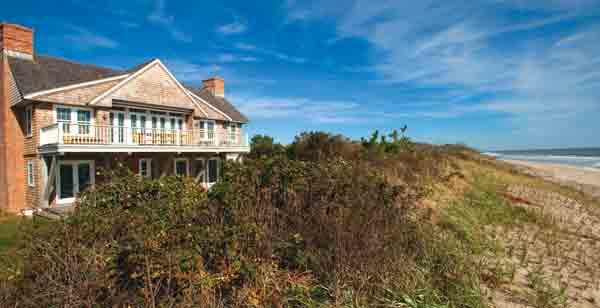Trending
When bigger isn’t better
New conservation measures have hit many villages, forcing smaller builds, but not everyone’s on board with eco-conscious construction

The tide may finally be turning on the “more is more” building trend that has dominated recent decades — though it depends who you talk to. On the East End, the bigger and bigger builds over the years have caused much hand-wringing among locals and prompted some villages to try to restrict building.
The past year has seen the towns of Southampton and East Hampton adopt new measures “discouraging large houses,” according to Hamptons architect Pamela Glazer. Now homes get assigned a number in the Home Energy Rating System Index (referred to as HERS), which penalizes larger homes.
“If your home is more than 4,500 square feet … You have to do a lot of green things to make your house comply,” Glazer said. “You might have to do complete solar and geothermal systems if you have a large house; it’s very difficult to get those numbers that they require.” And these technologies, which help homes make the grade, do not come cheap.
While the added cost of insulation or energy-efficient technologies isn’t keeping everyone from adding a few thousand square feet — it is the End End, after all — many industry insiders say there is more of a notable move these days toward building small and going green.
The Real Deal asked experts whether smaller, eco-friendly homes are really the next big thing out east, despite the region’s long and storied history of sprawling seaside mansions. These interviews have been edited for brevity and clarity.
Less is more
Martha Gundersen
Licensed Associate Real Estate Broker, Brown Harris Stevens
 Have you noticed people in the Hamptons looking for smaller houses? Yes. I think there’s a lot of reasons for it. Number one, there’s a lot of baby boomers downsizing, and they want less maintenance, less taxes, less worry. Also, they have less time to spend [in the Hamptons], so maybe they’re spending a month here and going somewhere warm, too. Another reason is there’s more restrictive zoning in the different areas. The sizes of the houses [based on] the zoning are getting smaller because you can’t build houses as big, and price per square foot is rising.
Have you noticed people in the Hamptons looking for smaller houses? Yes. I think there’s a lot of reasons for it. Number one, there’s a lot of baby boomers downsizing, and they want less maintenance, less taxes, less worry. Also, they have less time to spend [in the Hamptons], so maybe they’re spending a month here and going somewhere warm, too. Another reason is there’s more restrictive zoning in the different areas. The sizes of the houses [based on] the zoning are getting smaller because you can’t build houses as big, and price per square foot is rising.
Some people are also concerned more about the environmental impact and the footprint. They’re not spending as much. Of course, with price comes size. People are realizing that a lot of the rooms they thought they needed, they don’t use. This is a secondary home market, and there’s still the desire for an eight-bedroom house for family and extended family. But, generally speaking, I think there is a trend towards living in and buying small homes and having less worry about taking care of them.
I think enough is enough out here. There are a lot of houses out here right now that are just not being used. I think people respect the environment; one of the reasons they’re coming out here is to enjoy the beauty of nature.
What would you say is a small house in the Hamptons? I’d say a small house out here is anywhere from about 2,000 to 4,000 square feet. I think two of the really hot markets right now are the Amagansett Dunes and Sag Harbor village. Those houses are small, but those are two hot markets. Sag Harbor is village living near water; the other is purely beach living.
Do you see other measures being taken to conserve resources? I think so. That’s why you have a lot of these tech companies that emphasize solar or geothermal. A lot of the modern houses have these roofs that are planted with sedum plants that not only insulate the home, but also provide drainage for rain. The roofs not only look really beautiful, but they’re also very environmental conscious.
Pamela Glazer
Architect, Pamela Glazer Architect
 Many say homes are getting smaller out east. Do you think that’s true? That is true, thankfully. I’m doing two of them right now. One is a little over 2,000 square feet, one is a little under 2,000 square feet. That isn’t really tiny, but relative to Hamptons homes, that’s small. People out here say, “3,500 square feet, that’s such a small house.” And I’m thinking, I grew up with six kids in a 3,000-square-foot house that I don’t remember ever being crowded. We’re a little warped here. I really find that 2,000 square feet is modest, but it’s not uncomfortable. I think that people are thinking we don’t want all that load to take care of for the weekend.
Many say homes are getting smaller out east. Do you think that’s true? That is true, thankfully. I’m doing two of them right now. One is a little over 2,000 square feet, one is a little under 2,000 square feet. That isn’t really tiny, but relative to Hamptons homes, that’s small. People out here say, “3,500 square feet, that’s such a small house.” And I’m thinking, I grew up with six kids in a 3,000-square-foot house that I don’t remember ever being crowded. We’re a little warped here. I really find that 2,000 square feet is modest, but it’s not uncomfortable. I think that people are thinking we don’t want all that load to take care of for the weekend.
Our clients say, “We like to have friends, but we don’t want them to be too comfortable because they don’t leave.” I’ve heard that a little bit.
I would like to hear people say it from an environmental point of view because I think that’s probably one of the key reasons to do it. We had a very big change in the energy conservation code as of last year that the town of Southampton adopted, and East Hampton followed suit. What they do is require what’s called a HERS rating, which is a home energy rating system.
Do you see other measures being taken to conserve resources? Yes, absolutely, I think people are making an effort. I’ve put in a lot of geothermal systems, which are really fantastic because they literally use no fossil fuel to heat and cool their home and that’s huge. I love that. Sometimes people put in backup systems; many people don’t bother. So far, we’ve had no issues with them. Solar is becoming pretty standard for people. Those are the two most common [things] that I’m putting in.
I’m designing a house for myself, and I’m doing a lot more drastic environmental measures. But I get to do that because I can experiment a bit and if they don’t work, it’s only my house … A lot of the systems are a little bit less mainstream.
Have you seen other shifts in what people are looking for during the past year? It seems to me that people are putting more things that were once generally commercial in their homes. Better gyms, better spas, massage rooms, saunas. I’m putting a spa in a house right now and it has a sauna, a steam room, a massage room, a relaxation room with a fireplace, a gym and this big shower with a cold waterfall. Is that a sign of wanting privacy or just running out of things to put in your house?
Bigger is better
Viola Rouhani
Partner, Stelle Lomont Rouhani Architects
 Have clients in the Hamptons been requesting smaller builds? If anything, it seems like right now it’s more of a market for people who want to build bigger houses on bigger lots, and I see less of the 2,000- to 4,000-square-foot homes. But whenever people do come to us wanting a smaller house, it is usually because they want to simplify their lives or they know the pressures of having a bigger house.
Have clients in the Hamptons been requesting smaller builds? If anything, it seems like right now it’s more of a market for people who want to build bigger houses on bigger lots, and I see less of the 2,000- to 4,000-square-foot homes. But whenever people do come to us wanting a smaller house, it is usually because they want to simplify their lives or they know the pressures of having a bigger house.
Do your clients ever express the desire for a smaller home because of concerns about sustainability? That is often the case, actually, because people do want to tread more lightly on the ground and leave less of a footprint and less of an impact. And so a lot of the people that come to us, if they want the smaller homes, they are usually people who are very sustainability-minded. You would think that people who want a smaller house don’t want to spend the money. But you’d be surprised at how willing these homeowners are to do what’s right. They want to put in the solar panels and they want to do the geothermal system if they can.
We just actually renovated a little house — I’m not able to speak to who the client is, but it’s somebody that would surprise you. We basically spent two years renovating an 1,800-square-foot structure. So from that perspective, I do think people are not afraid of that. They feel some pride in it.
What other conservation methods are popular? The solar panels, of course. A lot of people are very interested in implementing these low-nitrogen sanitary systems. They’re now required by code in the town of East Hampton, but even before, we were approached by a bunch of people who really wanted to use that kind of technology, even though it was less widely available at that time. I think that’s a really big concern for people because they realize that part of what makes this area so beautiful and special is the water, and if you start to destroy the water quality, there’s not really going to be that attraction.
One thing that people are concerned about — it’s usually a couple that’s a little bit older and with grown children — is having a house that everybody can come to, but they’re very aware that a lot of the time it might just be them. There’s been this move to design houses in a way that you can live in just part of it without having to have the whole rest of it up and running to full capacity.
We’re doing one right now where the main portion of the house really consists of eating, living and dining with one really nice master suite. The other part of the house is set up more like guest rooms. If nobody’s there and nobody’s visiting them, then they can just keep that part of the house at a different temperature. They don’t have to have all the lights on or everything running for that portion.
Ed Bruehl
Associate Real Estate Broker, Saunders & Associates
 Are houses in the Hamptons getting smaller? It depends on the customers. There are two [types] that may look for a smaller place: one is a family who owns a rather substantial estate south of the highway in the hamlet of East Hampton, for example. They’ve loved it, they’ve lived in it and the kids go off to college. And Mom and Dad are like, “We don’t really need six bedrooms anymore.” The idea of turning on a house that size and turning off a house that size ends up becoming quite expensive and time consuming.
Are houses in the Hamptons getting smaller? It depends on the customers. There are two [types] that may look for a smaller place: one is a family who owns a rather substantial estate south of the highway in the hamlet of East Hampton, for example. They’ve loved it, they’ve lived in it and the kids go off to college. And Mom and Dad are like, “We don’t really need six bedrooms anymore.” The idea of turning on a house that size and turning off a house that size ends up becoming quite expensive and time consuming.
What’s crazy is there’s nothing to show. The average spec builder in this market is building a $4 million house. In order for him or her to get $4 million or more, it’s got to be 5,000 to 6,000 square feet. For a buyer who’s trading out of a 5,000- or 6,000-square-foot home looking for a clean, new 2,800-square-foot house, there’s nothing to look at. There’s absolutely nothing to look at. Nobody’s building that niche, except a few that went up on Whooping Hollow Road in East Hampton.
The other customer is a young, pregnant couple. We get tons of them. Classic story: “We just finished renovating the apartment in the city. It was a lot of work, but we really know what we want now, and we just don’t want to be in someone else’s older house. We want something new.” They don’t need 5,000 square feet with one kid on the way. They’re living on the same floor.
Do you see any measures related to conservation and sustainability being taken? In terms of carbon footprint, I’m a Californian who’s coming to New York, and we’re just not there yet. New York just doesn’t think about that the same way. Although there are people on certain sides of the aisle who like to say it matters, it’s important, people will pay for it … I don’t see that on the demand side yet. People don’t ask me for the carbon-zero houses.
Have you seen other shifts in what people are looking for during the past year? The Springs has absolutely turned on because it’s probably the most value under a million. Montauk ran ahead of the Springs, where you could go out there and get something in the $600,000s or the $700,000s or the $800,000s. Those days are over. Now everything is in the $900,000s or higher. So the Springs turned on; it became cool, kind of hip. They don’t mind being a bit farther away. Hampton Bays turned on.
The trend I’m seeing is about where can you find value. Buyers demand new construction or they demand absolute value, meaning price this thing to market. I’ve noticed that people want larger lots; privacy has gone from important to more important. The person who’s willing to live in the village will give up privacy for a small lot, because they really want to be in the village or they want to walk there. But privacy is very high on the must-have list.




